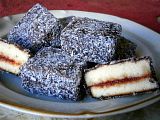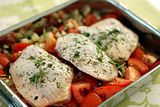
Since I baked this bread the first time I made it lots of times using sourdough instead of biga, halving the recipe, ad using my bread machine for mixing and after waiting for some time, baking it.
I find this recipe fantastic, the bread is soft as my children like it and it uses lots of my sourdough that I always try not to waste.
This time I had 100 gr of ricotta hanging around and some toasted hazelnuts so I added them to the recipe, adding a little more flour.
RECIPE
Biga
Source: Peter Reinhart, The Bread Baker's Apprentice Page 107
Makes about 18 ounces
Ingredients
2 1/2 cups (11.25 ounces) unbleached bread flour
1/2 teaspoon (.055 ounces) instant yeast
3/4 cup plus 2 tablespoons to 1 cup (7-8 ounces) water, at room temperature
Directions
1. Stir together the flour and yeast in a 4-quart bowl (or in the bowl of an electric mixer). Add 3/4 cup plus 2 tablespoons of the water, stirring until everything comes together and makes a coarse ball (or mix on low speed for 1 minute with the paddle attachment). Adjust the flour or water, according to need, so that the dough is neither too sticky nor too stiff. (It is better to err on the sticky side, as you can adjust easier during kneading. It is harder to add water once the dough firms up.)
2. Sprinkle some flour on the counter and transfer the dough to the counter. Knead for 4 to 6 minutes (or mix on medium speed with the dough hook for 4 minutes), or until the dough is soft and pliable, tacky but not sticky. The internal temperature should be 77 to 80 degrees F.
3. Lightly oil a bowl and transfer the dough to the bowl, rolling it around to coat it with oil. Cover the bowl with plastic wrap and ferment at room temperature for 2 to 4 hours, or until it nearly doubles in size.
4. Remove the dough from the bowl, knead it lightly to degas, and return it to the bowl, covering the bowl with plastic wrap. Place the bowl in the refrigerator overnight. You can keep this in the refrigerator for up to 3 days, or freeze it in an airtight plastic bag for up to 3 months.
Source: Peter Reinhart, The Bread Baker's Apprentice Page 107
Makes about 18 ounces
Ingredients
2 1/2 cups (11.25 ounces) unbleached bread flour
1/2 teaspoon (.055 ounces) instant yeast
3/4 cup plus 2 tablespoons to 1 cup (7-8 ounces) water, at room temperature
Directions
1. Stir together the flour and yeast in a 4-quart bowl (or in the bowl of an electric mixer). Add 3/4 cup plus 2 tablespoons of the water, stirring until everything comes together and makes a coarse ball (or mix on low speed for 1 minute with the paddle attachment). Adjust the flour or water, according to need, so that the dough is neither too sticky nor too stiff. (It is better to err on the sticky side, as you can adjust easier during kneading. It is harder to add water once the dough firms up.)
2. Sprinkle some flour on the counter and transfer the dough to the counter. Knead for 4 to 6 minutes (or mix on medium speed with the dough hook for 4 minutes), or until the dough is soft and pliable, tacky but not sticky. The internal temperature should be 77 to 80 degrees F.
3. Lightly oil a bowl and transfer the dough to the bowl, rolling it around to coat it with oil. Cover the bowl with plastic wrap and ferment at room temperature for 2 to 4 hours, or until it nearly doubles in size.
4. Remove the dough from the bowl, knead it lightly to degas, and return it to the bowl, covering the bowl with plastic wrap. Place the bowl in the refrigerator overnight. You can keep this in the refrigerator for up to 3 days, or freeze it in an airtight plastic bag for up to 3 months.
Italian Bread
Source: Peter Reinhart, The Bread Baker's Apprentice Page 172-173
Days to make: 2
Day 1: 3 to 4 hours biga
Day 2: 1 hour to dechill biga; 12-15 minutes mixing; 3 1/2 hours fermentation, shaping, and proofing; 20-30 minutes baking
Makes two 1 pound loaves or 9 torpedo (hoagie) rolls
Ingredients
3 1/2 cups (18 ounces) biga (recipe above)
2 1/2 cups (11.25 ounces) unbleached bread flour
1 2/3 teaspoons (.41 ounces) salt
1 tablespoon (.5 ounce) sugar
1 teaspoon (.11 ounce) instant yeast
1 teaspoon (.17 ounce) diastatic barley malt powder (optional)
1 tablespoon (.5 ounce) olive oil, vegetable oil, or shortening
3/4 cup to 3/4 cup plus 2 tablespoons (7 to 8 ounces) water (or milk if making torpedo rolls), lukewarm (90 to 100 F)
Semolina flour or cornmeal for dusting
Directions
1. Remove the biga from the refrigerator 1 hour before making the dough. Cut it into about 10 small pieces with a pastry scraper or serrated knife. Cover with a towel or plastic wrap and let it sit for 1 hour to take off the chill.
Source: Peter Reinhart, The Bread Baker's Apprentice Page 172-173
Days to make: 2
Day 1: 3 to 4 hours biga
Day 2: 1 hour to dechill biga; 12-15 minutes mixing; 3 1/2 hours fermentation, shaping, and proofing; 20-30 minutes baking
Makes two 1 pound loaves or 9 torpedo (hoagie) rolls
Ingredients
3 1/2 cups (18 ounces) biga (recipe above)
2 1/2 cups (11.25 ounces) unbleached bread flour
1 2/3 teaspoons (.41 ounces) salt
1 tablespoon (.5 ounce) sugar
1 teaspoon (.11 ounce) instant yeast
1 teaspoon (.17 ounce) diastatic barley malt powder (optional)
1 tablespoon (.5 ounce) olive oil, vegetable oil, or shortening
3/4 cup to 3/4 cup plus 2 tablespoons (7 to 8 ounces) water (or milk if making torpedo rolls), lukewarm (90 to 100 F)
Semolina flour or cornmeal for dusting
Directions
1. Remove the biga from the refrigerator 1 hour before making the dough. Cut it into about 10 small pieces with a pastry scraper or serrated knife. Cover with a towel or plastic wrap and let it sit for 1 hour to take off the chill.
2. Stir together the flour, salt, sugar, yeast and malt powder in a 4 quart bowl (or in the bowl of an electric mixer). Add the biga pieces, olive oil, and 3/4 cup water and stir together (or mix on low speed with the paddle attachment) until a ball forms, adjusting the water or flour according to need. The dough should be slightly sticky and soft, but not batter like or very sticky. If the dough feels tough and stiff, add more water to soften (it is better to have the dough too soft than too stiff at this point).
3. Sprinkle flour on the counter, transfer the dough to the counter, and begin kneading (or mixing on medium speed with the dough hook). Knead (or mix) for about 10 minutes, adding flour as needed, until the dough is tacky, but not sticky, and supple. The dough should pass the windowpane test and register 77-81 F. Lightly oil a large bowl and transfer the dough to the bowl, rolling it to coat it with the oil. Cover the bowl with plastic wrap.
4. Ferment at room temperature for approximately 2 hours, or until the dough doubles in size.
5. Gently divide the dough into 2 equal pieces of about 18 ounces each, or into 9 pieces of about 4 ounces each (for torpedo rolls). Carefully form the pieces into batards, or rolls, degassing the dough as little possible. Lightly dust with a sprinkle of flour, cover with a towel or plastic wrap, and let rest 5 minutes. Then complete the shaping, extending the loaves to about 12 inches in length or shaping the torpedo rolls. Line a sheet pan with baking parchment and dust with semolina flour or cornmeal. Place the loaves on the pan and lightly mist with spray oil. Cover loosely with plastic wrap.
6. Proof at room temperature for about 1 hour, or until the loaves or rolls have grown to about 1 1/2 times their original size.
7. Prepare the oven for hearth baking, making sure to have an empty steam pan in place. Preheat the oven to 500 F. Score the breads with 2 parallel, diagonal slashes or 1 long slash.
8. Rolls can be baked directly on the sheet pan. For loaves, generously dust a peel or the back of a sheet pan with semolina flour or cornmeal and very gently transfer the loaves to the peel or pan. Transfer the dough to the baking stone (or bake on the sheet pan). Pour 1 cup hot water into the steam pan and close the door. Repeat once more after another 30 seconds. After the final spray, lover the oven setting to 450F and bake until done, rotating 180 degrees in necessary, for even baking. It should take about 20 minutes for the loaves and 15 minutes for the rolls. The loaves and rolls should be golden brown and register at least 200F at the center.
9. Transfer the rolls or loaves to a cooling rack and cool for at least 1 hour before slicing or serving.
Mando questa ricetta a Zucchero & Canella per i suoi mercoledì.
Questo pane viene benissimo nella macchina del pane, faccio fare l'impasto poi aspetto un po' a seconda della temperatura e cuocio sempre nella macchina del pane.
Io sostituisco alla biga la pasta madre e dimezzo la ricetta, in questo caso ci ho anche aggiunto un etto di ricotta e un etto di nocciole tostate aggiungendo un po' di farina se serve.
























































































.jpg)













.jpg)





































